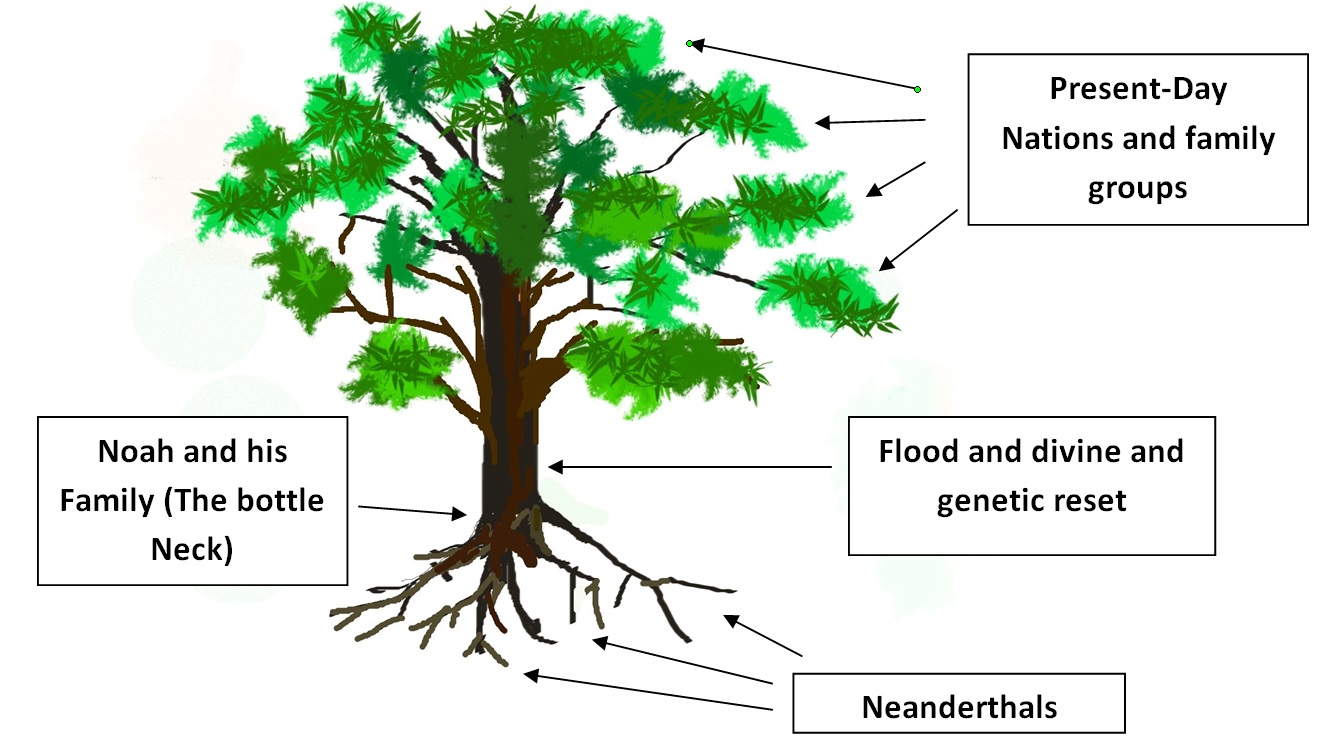 You have a lot of Neanderthal DNA. At least 99.5 percent of your DNA is identical to Neanderthal 1. Recent DNA sequencing is revealing the truth of Neanderthal, and it is time to bury all our preconceived ideas about him and start afresh allowing DNA to be our guide. We have been led to believe that Neanderthal is our ancient, hairy, brutish, ape-like, ignorant, slumped-over cousin who went extinct because he was inept. His DNA, however, is shouting out to us that this is not the case. He is 99.5 percent like us. This 99.5 percent similarity is not based on our opinion or our analysis; it is based on published secular scientific papers. By the way, we present-day humans share this same amount of DNA, 99.5 percent, with one another 2. It does not matter whether you are European, African, Asian, American or Australian, you are all very closely related to Neanderthal. The 0.5 percent that separates us from one another and Neanderthal lies in our genetic markers. * These genetic markers provide humanity with natural variation and the ability to trace human ancestry.
You have a lot of Neanderthal DNA. At least 99.5 percent of your DNA is identical to Neanderthal 1. Recent DNA sequencing is revealing the truth of Neanderthal, and it is time to bury all our preconceived ideas about him and start afresh allowing DNA to be our guide. We have been led to believe that Neanderthal is our ancient, hairy, brutish, ape-like, ignorant, slumped-over cousin who went extinct because he was inept. His DNA, however, is shouting out to us that this is not the case. He is 99.5 percent like us. This 99.5 percent similarity is not based on our opinion or our analysis; it is based on published secular scientific papers. By the way, we present-day humans share this same amount of DNA, 99.5 percent, with one another 2. It does not matter whether you are European, African, Asian, American or Australian, you are all very closely related to Neanderthal. The 0.5 percent that separates us from one another and Neanderthal lies in our genetic markers. * These genetic markers provide humanity with natural variation and the ability to trace human ancestry.
DNA can and will solve the mystery of Neanderthal
So, let’s follow the Neanderthal DNA and see where it takes us in rebuilding our perception. Thanks to the work of many scientists, we now have a draft sequence of the full Neanderthal DNA 3. And thanks to several private laboratories, these DNA sequences, and genetic markers are being translated into physical characteristics. Here are several examples of what is being discovered about Neanderthal:
- Neanderthal falls inside the variation of present-day human DNA 3; therefore, it would be difficult to conclude anything other than Neanderthal being fully human. He shares the status, of “made in the image and likeness of God” (Genesis 1:26) with us.
- Neanderthal had less hair on his back than many present-day humans. This is due to genetic marker rs4849721. This marker is shared by Neanderthal and present-day humans. If you have a T at this marker position, you probably have less back hair than average 4. Neanderthals have the T which means that they too probably had less back hair than the average present-day human. Hmmm, so much for the hairy ape-man image.
- Neanderthals had freckles 5. People with light skin get freckles because they have less melanin in their skin which causes uneven tanning. It appears that freckles are now in vogue. Some of our most popular movie stars have them. So, Neanderthals are not just human, but “in vogue” humans.
- Several Neanderthal DNA sequences have genes indicative of red hair 5 and blue eyes
 . This does not mean that all Neanderthal had red hair and blue eyes, but at least some had these characteristics. By now, hopefully, you can see that at least some Neanderthals would look like someone you would bump into at a St. Patrick’s Day celebration.
. This does not mean that all Neanderthal had red hair and blue eyes, but at least some had these characteristics. By now, hopefully, you can see that at least some Neanderthals would look like someone you would bump into at a St. Patrick’s Day celebration. - Neanderthal shares the FOXP2 gene 6 with us indicating that he was capable of complex speech just as we are. Also, it is generally accepted that Neanderthal had a larger brain 7 than present-day man which opens the possibility that he was more articulate than we are.
- Although Neanderthals share 99.5 percent of our total DNA, they share only 98.7 percent of our mitochondrial DNA (mtDNA). This is interesting and can be explained. Mitochondrial DNA is a primary contributor to our energy, strength, and length of life. The fact that Neanderthal mtDNA differs from us by 1.3 percent fits the fossil evidence nicely. Neanderthal fossils are indicative of them having better muscle tone, more strength, and better bone structure than we have. In short, he was buff. Also, some mature Neanderthals had a prominent brow ridge indicative of them living long lives 8.
- Neanderthals, in general, have less genetic diversity than we have; however, researchers are finding little, or no evidence of incest 9. This, in my opinion, signifies that Neanderthal had complex relationship structures, as do we. Maybe he came calling with a bouquet of flowers, a box of chocolates, and an articulate, witty proposal.
According to DNA, Neanderthal is 99.5 percent like you. He was not a hairy, ignorant, inept, ape-man. He was human, created in the image of God just like you. So, the obvious question is, where does Neanderthal fit into the chronicles of human history? Where do you think he fits? We have our opinion (click here), but we will leave it to you to make up your own mind.
Commentary Note: You may have heard that some geneticists proclaim that we have only a small amount of Neanderthal DNA; some say 2-4 percent, some say 0 percent, and some say 20 percent. These claims come from the same scientific community that says we share 99.5 percent of our DNA with Neanderthal. Why this huge conflict? I will not attempt to explain where these low numbers come from; you would think I am making it up. Suffice it to say, the 99.5 percent is correct, and the lower numbers are contrived to justify the “out of Africa” and evolutionary hypotheses. To demonstrate this point, ask yourself the question, how can we share only 2-4 percent with Neanderthal and 50 percent of our DNA with the banana? The DNA sequences are available to the public and can be verified and viewed by anyone.
New details on Neanderthal are emerging every day as are the reconstructions of Neanderthal’s physical appearance. We will keep you posted: You can Subscribe Here if you like.
* Genetic markers – Single Nucleotide polymorphisms, microsatellites, short tandem repeats, et. al.
References:
- https://www.ncbi.nlm.nih.gov/pmc/articles/PMC2583069/
- https://www.genome.gov/10001551/genetic-variation-program/
- https://www.ncbi.nlm.nih.gov/pmc/articles/PMC5100745/
- https://www.snpedia.com/index.php/Neanderthal/
- https://www.ncbi.nlm.nih.gov/pubmed/17962522/
- https://www.ncbi.nlm.nih.gov/pmc/articles/PMC4766443/
- https://blog.nationalgeographic.org/2008/09/09/neanderthal-brain-size- at-birth-sheds-light-on-human-evolution/
- Cuozzo J., (1998) “Buried Alive the Startling Truth About Neanderthal Man,” Master Books Inc.
- http://www.cam.ac.uk/research/news/prehistoric-humans-are-likely-to-have-formed-mating-networks-to-avoid-inbreeding


